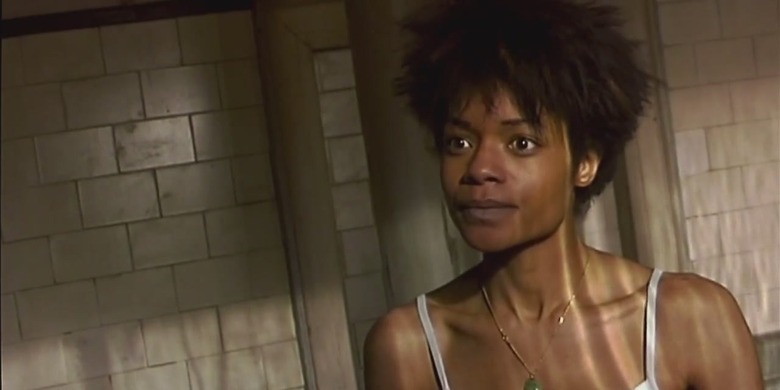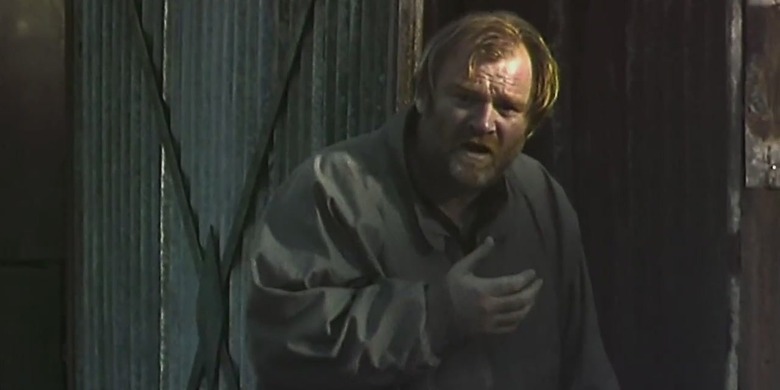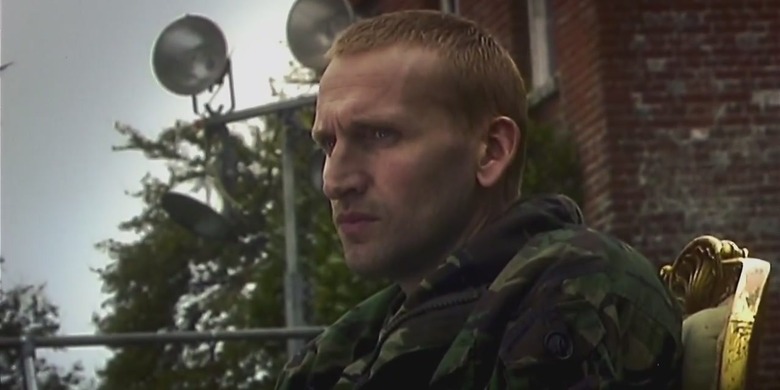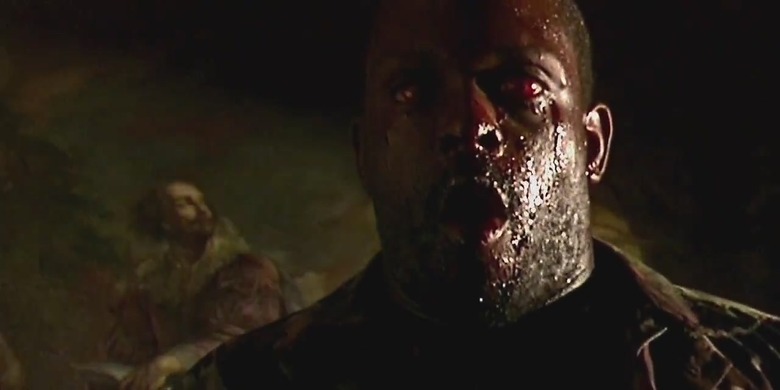15 Years Later, '28 Days Later' Is The Raging Horror Movie For Our Dark Times
On this week in 2003, 28 Days Later entered wide release in the U.S., prepping audiences for The Walking Dead and the zombie craze to come. The world is a lot different now than it was when Danny Boyle's post-apocalyptic horror film burst onto the scene with its red-eyed, fast-running zombies. This was before Facebook, before Twitter, before Instagram. It was even before /Film. Yet now more than ever, the movie's fictional "rage virus" is a potent symbol for our ever-evolving, rage-infected culture.
Zombies in the Ether
A coma patient wakes up in a world overrun by zombies. Before he understands the nature of this new nightmarish landscape, he wanders around a spooky, abandoned hospital. At one point, he picks up the phone, but the line is dead. Later he is seen as a lone figure against the backdrop of an abandoned city. Eventually, he bands together with other survivors and they soon learn that the real horror is other humans.
Resisting the urge to make a "Boom goes the dynamite!" joke (we'll leave that to the voices of the /Filmcast), it's enough to say that AMC's The Walking Dead is in some ways just an extended riff on 28 Days Later, with Atlanta and the Georgia backwoods switched out for London and the meadows of England. The difference between these two zombie apocalypse tales, one longform, the other short-form, is the difference between a series of meandering novels and a single effective short story. Whereas the show has chosen to draw out its worldview over eight seasons of television and counting, the movie is able to tell you everything it thinks you need to know about humanity in the span of two hours.
In an interview with Entertainment Weekly after the pilot episode of The Walking Dead aired, creator Robert Kirkman had this to say about the notable similarities between 28 Days Later, his own comic book series, and the TV show based on it:
"It was complete coincidence. I saw 28 Days Later shortly before the first issue of Walking Dead was released. That first issue came out in October of 2003 and 28 Days Later was released in the States in June of 2003. So we were working on our second issue by the time I saw it."
Maybe zombies were just in the ether back in 2003. Whatever the case, it would be another seven years before The Walking Dead made it to the small screen and that might never have happened had 28 Days Later not first paved the way for the zombie resurgence on celluloid. 2004 saw the release of Zack Snyder's Dawn of the Dead remake and Edgar Wright's "zom-com" Shaun of the Dead, and those were just the first of many new mainstream zombie movies that followed on the heels of 28 Days Later.
15 Years (5,475 Days) Later
As a director, Danny Boyle was known largely for Trainspotting and other British black comedies prior to 28 Days Later. With The Beach, his adaptation of Alex Garland's novel, he had started branching out into drama, working with his first big movie star, Leonardo DiCaprio, but then he went and made a curious career move, re-teaming with Garland to shoot a zombie movie digitally with a Dogme 95 cinematographer.
It just so happened to be one of the best horror films of the 2000s. These days, Boyle is an Academy Award-winning filmmaker who is preparing to take on the tentpole of the 25th James Bond movie, while Garland has come into his own as a director to rival the young Ridley Scott with his back-to-back science fiction gems Ex Machina and Annihilation.
The faces in front of the camera have since gone on to great things, too. 28 Days Later introduced the world to Cillian Murphy, who would later don the Scarecrow mask in Batman Begins and a razor-lined newsboy cap in Peaky Blinders. Naomie Harris was also an unknown at the time but now she's recognizable for such roles as Moneypenny in Skyfall and the crack-addicted mother in Moonlight (the latter of which earned her an Oscar nomination). Brendan Gleeson and Christopher Eccleston, both of whom play memorable supporting characters in the movie, were more established actors, but their stateside fame would increase, most recently landing them on Mr. Mercedes and The Leftovers, respectively.
As a zombie movie, 28 Days Later bucked standards in its treatment of the way zombies move. Forget walkers. These zombies were runners, more like the galloping dead. Films such as World War Z have since carried the fast-zombie ball further, but as late as 2008, you could still see self-identified zombie "purists" like Simon Pegg penning convincing essays for The Guardian about why zombies, as avatars of creeping mortality, should never be allowed to run. Even today, hardcore fans might want to play semantics and say 28 Days Later doesn't truly belong to the zombie film genre (though perhaps one way of looking at it would be to say that it invented a new sub-genre).
If it isn't a zombie movie, then what is it? Slate called 28 Days Later a zombie flick turned humanist parable. Starting with Night of the Living Dead (required viewing for horror newbies), the late George Romero proved adept at interweaving social commentary with his pioneering zombie films. If nothing else, 28 Days Later is a film that keeps that social commentary tradition very much alive.
The Tyranny of Toxic Rage
Cinematically, has there ever been a sturdier indictment of toxic rage than the concept of the rage virus? That's the twist on zombie infection that 28 Days Later offers up. All it takes is one nasty bite or a single drop of blood falling into a person's eye to activate the rage virus. This can make a loving father flip on a dime, lashing out at his daughter like an animal after he has just gotten done saying, "I'm sorry I lost my temper. I love you very much."
Toxicity isn't limited to fandom or online culture (though /Film Daily has a whole podcast episode on that if you're in the mood for some listening therapy). It permeates all aspects of human society, from the home to the workplace to people's public encounters. 28 Days Later starts out with footage of rioting and lynch mobs, then the camera pulls back to reveal a line of monitors playing this footage for a chimpanzee strapped to a table.
That's an apt signifier for the way many of us experience the world in the 21st century. The Internet just happens to give people an easier platform for being confrontational, delivering drone-strike words without the consequences of a face-to-face engagement.
When asked what issues he was trying to explore with 28 Days Later, Boyle said:
"Social rage. There's a very specific social intolerance of each other ... It's not just road rage. You get it in hospital waiting rooms and you get it in airplanes and airports. It seems to be a speed fixation. When it's not delivered at the speed desired, people just lose it."
Intolerance can certainly breed rage, but what Boyle also seems to be talking about here is people's need for instant gratification. That's something that has only gotten amped up more in the last decade and a half. The film's fast-moving, outside-the-genre-box zombies are an extension of our own frantic minds. In that way, 28 Days Later is timelier than ever.
Neurotic singles used to identify with that cringe-inducing scene in Swingers where Jon Favreau's character has the answering-machine meltdown and can't exercise enough restraint to keep from compulsively calling back and leaving repeated messages. Now they're more likely to identify with the scene in Chef where Favreau's character sends out the tweet heard 'round the world. Itchy trigger-fingers have evolved to become itchy Twitter-fingers.
As trite as it might seem to trot out social media as a movie monster, a damning picture of it does start to form when you view it through the blood-red filter of 28 Days Later. On the Internet, as in life, no one's hands are clean. Irate comments and tweets are certainly lamentable, but in the rush to keep up with deadlines and the online news cycle, members of the movie blogosphere are sometimes as guilty as anyone else of perpetuating the rage virus. Behind a comfy keyboard, the same seemingly rational person who preaches civility in film discourse might then turn around and hurl expletives at a customer service rep or unleash a torrent of abusive words at a politician.
In the face of injustice, of course, some things do call for a measure of righteous indignation, perhaps even outrage...but that's where being a decent human gets tricky. This is what makes the trajectory of Cillian Murphy's character, Jim, in 28 Days Later so interesting and morally complex.
Tread carefully, apocalypse survivors. We are entering a dangerous new stretch of the zombie-training obstacle course now and you'll want to be vigilant of the posted sign reading, "Spoilers ahead." If you haven't seen 28 Days Later or its sequel, pause here, watch them, and return.
This is the Way the World Ends
Toward the end of 28 Days Later, Jim, too, is forced to regress to an almost primal state, running around shirtless and bloodied, carrying out swift, decisive action against would-be rapists. Scoped through the aggressive lens of a reptilian brain, it's tempting to see oneself as that kind of full-blooded fairy tale hero; but everybody's a walking contradiction and that brings with it a degree of inborn hypocrisy.
Unlike the English country house at the end of 28 Days Later with its clearly identifiable villains, the real world tends to be grayer, populated by a lot of other Jims and Janes who are all running around the same dark mansion, trying to play judge, jury, and executioner with each other to the tune of "In the House, in a Heartbeat." Maybe it's true, as the song goes, that there's a season to everything, even a time for anger (to quote the Terminator, "Anger is more useful than despair"), yet people have wildly different definitions of what's just or unjust and even discriminate anger can be misplaced or channeled in an unhealthy manner.
That's the horror of 28 Days Later. It's the horror of seeing your fellow survivors succumb to rabies and become monsters, or worse still, remain human yet stoop to the same horrific level as the Army Major who says of his soldiers: "I promised them women."
In the movie, the first encounter that Jim has with the infected happens in a church: somewhere that should be a place of sanctuary. When Jim goes back to check on his parents in his childhood home, his neighbors literally come crashing through the windows, trying to kill him. "That's Mr. Bridges," he whimpers. "That's his daughter. They live four doors down."
Selena, the character played by Naomie Harris, explains the phenomenon like this:
"It started as rioting, and right from the beginning, you knew this was different, because it was happening in small villages, market towns. And then it wasn't on the TV anymore. It was in the street outside, it was coming through your windows. It was a virus, an infection. You didn't need a doctor to tell you that."
This is the way the world ends, beginning with the animal rights activist who tries to do the right thing and free a suffering chimp, only to have it leap out of its cage and viciously attack her.
Let Them Eat Flesh
If traditional zombies are death personified, then the hyperkinetic, red-eyed zombies in 28 Days Later are a personification of the ruthless barbarism lurking within all of us. Senseless inhumanity is documented on the news every day. However, if you follow Chef Carl Casper's example and pop in on Twitter — do a little scrolling — it can sometimes feel like the outside observer is peeking in on the same level of social unrest as the French Revolution. People are seized by the mob mentality in reaction to various controversies and in the end, personal freedom and social change (or the illusion of it) wind up being bought in blood. The violent bear it away.
Recent headlines have reintroduced the name Marie Antoinette into the zeitgeist, alluding to the historical queen's clueless quote, "Let them eat cake"—which she may not have actually said. Our increasingly cannibalistic culture (this includes pop culture, which is looping back and eating itself) has no patience for cake. It's content to eat flesh. Modernity is a meat-grinder.
Crowds have always loved a good public execution throughout human history, but since it's not socially acceptable to feed the guillotine anymore, civilization has learned to sublimate its violence into new forms. The makers of 28 Days Later might not have had social media and the exact same social problems of 2018 in mind when they mounted their film production, but now that we have this technology connecting us (or disconnecting us, as the case may be), there's a frightening comparison to be drawn between the actions of rage virus carriers and the behavior of angry Internet mobs.
Spin the wheel of public figures (who will it land on next?), and with alarming speed and vehemence, a horde of entitled strangers will rise up to criticize and condemn, even going so far as to harass people they've never met in real life for offenses both imagined and real. Woe betide the creative person involved in any perceived mishandling of some beloved intellectual property. As absurd as it seems, death threats from disgruntled fans are a real occupational hazard for storytellers. It's as if Annie Wilkes and all her homicidal book-nerd obsession have inherited the earth. Hate goes viral and so does sadness, it seems, with recent high-profile celebrity deaths bringing the phrase "suicide contagion" into usage in the media.
In a society ruled by what The New York Times calls "the politics of rage" and the limits of blanket belief, those of us hoping to find a separate peace in the midst of all this madness can only don riot gear and retreat to our tower block apartments with blinking Christmas lights, just like Brendan Gleeson's character, Frank, and his daughter in 28 Days Later. But how long will it be safe up there in those ivory towers? Meanwhile, Manchester is burning.
With everything said here, there's another whole dimension to the herd or horde mentality that we haven't even touched on and that's the part that eschews blind rage in favor of calm and convinced judgmentalism. In a way, that kind of mob rule is almost scarier because it comes from sedate, civilized pronouncements spoken through the mouths of man-boys and other overprivileged children.
What happens when the rage virus carriers stop freaking out and start buttoning themselves up and drinking lattes? Then you've got a pair of crimson eyes staring across from you at the conference table. Through his beard of blood, the rage virus carrier smiles at you, and you smile back, but you both know: he'd kill you if he had the chance. All it would take is one of his boardroom associates pointing the finger at you and saying your necktie looks bad.
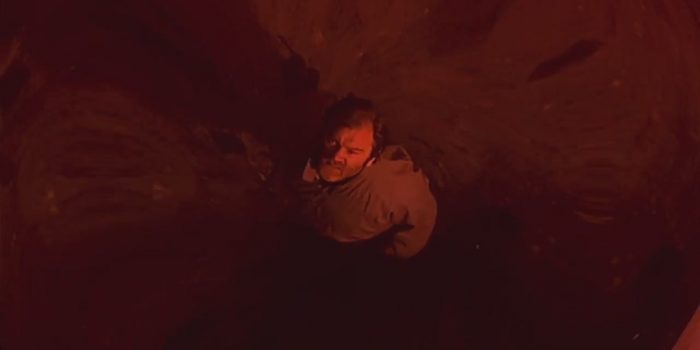
One Little Drop
It's like that scene in the sequel, 28 Weeks Later, when the snipers start going to town on the stampede where a bunch of rage virus carriers are mixed in with panicking civilians. After much ado over the radio about only targeting the infected and watching out for "the friendlies," the appropriately named Brigadier General Stone, played by Idris Elba, finally decides to throw off all pretense in this confused mess of sniping, delivering the order to, "Abandon selective targeting. Shoot everything."
Even he has to admit: "We've lost control." And when Idris Elba says something, you know it's true. If only he were able to cancel the apocalypse here like he did in Pacific Rim.
As he is being led away to die in 28 Days Later, the one good sergeant in the unit of bad soldiers tells his executioner, "I swear to God, it's gonna end badly for you." Even though the sergeant is doomed, it feels like a tiny moral victory for him and the audience because he's commending his well-deserved revenge to a higher fate, trusting that the long arc of the universe will indeed bend toward justice.
The other option is to do what Sheriff Ed Tom Bell says in No Country for Old Men and put your soul at hazard, moving out to meet the monsters on their own home turf (namely, this planet). You can go Jim's way and take matters into your own hands, but that doesn't always lead to a happy ending where all the friendlies in one's orbit are concerned.
It's framed as a brute rescue, but there's a disturbing moment in 28 Days Later when Jim resorts to an act of pure savagery, his blood-spattered face staring down implacably as he gouges another man's eyes out. Perhaps deliberately, a scene with Robert Carlyle in 28 Weeks Later mirrors this moment, only in that case, Carlyle's character, Don, has actually gone full rage virus and he's gouging his own wife's eyes out. Personally, that scene remains one of the more horrifying things I've ever seen on film, so it's hard for me to reconcile that with what Jim does, even if he has a steadier moral compass than the cowardly Don.
As he rises back up into the shadows, even Selena doesn't know what to make of Jim after the eye-gouging incident. Has he been turned? Is he infected?
That's what it feels like to be alive in 2018, trying to stay level-headed, trying to hold onto some semblance of humanity as the world goes to hell in a handbasket. If you're one of the good guys, a person who stands apart from the bloodthirsty mob (someone who's careful, conscientious, and constructive, not destructive), that's encouraging. But be wary of that black crow pecking at a dead body on the balcony above you. All it takes is one blood drop in your eye to infect you with the rage virus.

